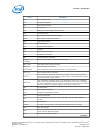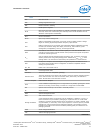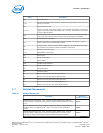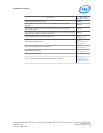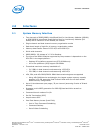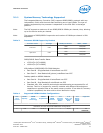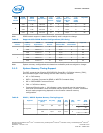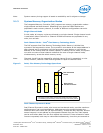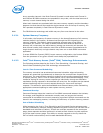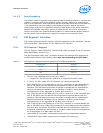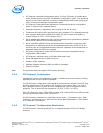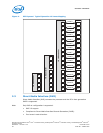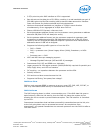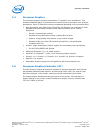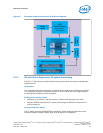
be on opposite channels. Use Dual-Channel Symmetric mode when both Channel A
and Channel B DIMM connectors are populated in any order, with the total amount of
memory in each channel being the same.
When both channels are populated with the same memory capacity and the boundary
between the dual channel zone and the single channel zone is the top of memory, the
IMC operates completely in Dual-Channel Symmetric mode.
Note: The DRAM device technology and width may vary from one channel to the other.
System Memory Frequency
In all modes, the frequency of system memory is the lowest frequency of all memory
modules placed in the system, as determined through the SPD registers on the
memory modules. The system memory controller supports one or two DIMM
connectors per channel. The usage of DIMM modules with different latencies is
allowed, but in that case, the worst latency (among two channels) will be used. For
dual-channel modes, both channels must have a DIMM connector populated and for
single-channel mode only a single channel may have one or both DIMM connectors
populated.
Note: In a two-DIMM Per Channel (2DPC) layout memory configuration, the furthest DIMM
from the processor of any given channel must always be populated first.
Intel
®
Fast Memory Access (Intel
®
FMA) Technology Enhancements
The following sections describe the Just-in-Time Scheduling, Command Overlap, and
Out-of-Order Scheduling Intel FMA technology enhancements.
Just-in-Time Command Scheduling
The memory controller has an advanced command scheduler where all pending
requests are examined simultaneously to determine the most efficient request to be
issued next. The most efficient request is picked from all pending requests and issued
to system memory Just-in-Time to make optimal use of Command Overlapping. Thus,
instead of having all memory access requests go individually through an arbitration
mechanism forcing requests to be executed one at a time, the requests can be started
without interfering with the current request allowing for concurrent issuing of
requests. This allows for optimized bandwidth and reduced latency while maintaining
appropriate command spacing to meet system memory protocol.
Command Overlap
Command Overlap allows the insertion of the DRAM commands between the Activate,
Pre-charge, and Read/Write commands normally used, as long as the inserted
commands do not affect the currently executing command. Multiple commands can be
issued in an overlapping manner, increasing the efficiency of system memory protocol.
Out-of-Order Scheduling
While leveraging the Just-in-Time Scheduling and Command Overlap enhancements,
the IMC continuously monitors pending requests to system memory for the best use of
bandwidth and reduction of latency. If there are multiple requests to the same open
page, these requests would be launched in a back-to-back manner to make optimum
use of the open memory page. This ability to reorder requests on the fly allows the
IMC to further reduce latency and increase bandwidth efficiency.
2.1.3.1
2.1.3.2
Processor—Interfaces
Desktop 4th Generation Intel
®
Core
™
Processor Family, Desktop Intel
®
Pentium
®
Processor Family, and Desktop Intel
®
Celeron
®
Processor Family
Datasheet – Volume 1 of 2 December 2013
22 Order No.: 328897-004



